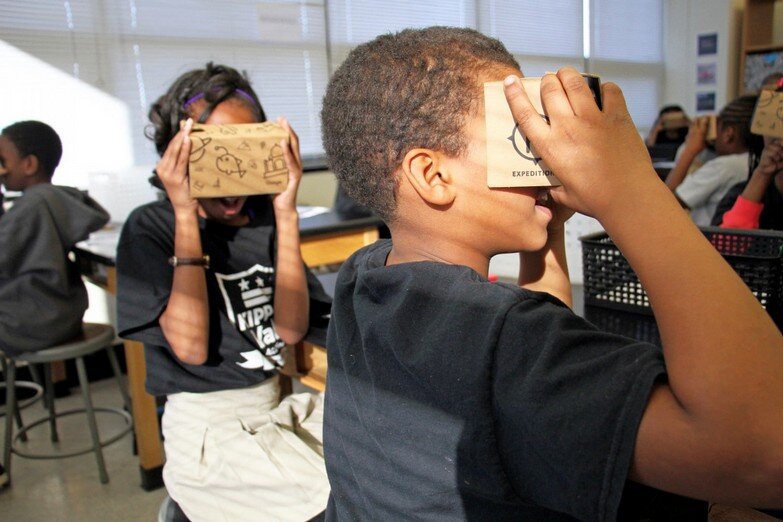
By Josh Boots | 9-10-2019
Fast-improving D.C. schools have important lessons to teach

Students at Valor Elementary. (Ashley Lemley for KIPP DC)
Josh Boots is executive director of EmpowerK12, a D.C.-based nonprofit that supports the city’s traditional public and public charter schools to implement data-driven instructional practices.
When last year’s fifth graders at Tubman Elementary showed up for the first day of sixth grade at Columbia Heights Education Campus last month, there were already teachers at their middle school who knew them. Teachers at CHEC, as the Northwest D.C. school is known, visited Tubman last spring. And that simple, yet rare, collaboration between one school that feeds into the other is one reason these two campuses are among the most successful in the District at raising student achievement for kids who face big challenges outside of school.
At CHEC and Tubman, along with 11 other schools my organization, EmpowerK12, recently identified, student achievement by our city’s least advantaged students is improving at rates 10 times faster than at other schools in the District and nationally. There’s no single reason. Rather, it’s an intentional combination of small and big things these schools do to keep their focus on where students need help.
Commonly, the students who need the most help are those classified as “at-risk of academic failure.” It’s a designation in schools, but it’s because of their lives outside of school. A student is considered “at-risk” if he or she is homeless, in foster care or the family qualifies for food stamps or Temporary Assistance for Needy Families. In high schools, students at least a year older than their grade level are also at-risk.
Nearly half of D.C. students in public schools are considered at-risk — an astounding percentage that should never fail to shake us. On top of their socioeconomic circumstances, many also have disabilities that make their learning — and teaching them — more challenging. For these doubly disadvantaged students, the Bold Improvement schools, as we call them, are making exceptional strides, too.
So, as we begin another school year, what can we learn from these schools? That’s what my colleagues and I sought to find out by visiting them. Teachers, school leaders and other staff identified several practices that they feel are most responsible for the rising levels of achievement at their schools:
- They use data and information in frequent and intentional ways. Sometimes student performance on morning tasks informs what extra help they get that same afternoon. At Langdon Elementary, for example, student groupings change weekly to match children to the teacher known to be best at teaching the skill they are having trouble mastering. Children move between classrooms and even grade levels.
- They collaborate across classrooms as well as across schools. The “bridge” program that links Tubman and CHEC is an example of this practice. Another example: School leaders at three charter elementary schools, KIPP Heights, KIPP Promise and KIPP Valor, meet frequently, visit each other’s campuses and share data to get better.
- They ensure students are ready to learn by creating a warm social-emotional environment. Bold Improvement schools prioritize social-emotional skills and beliefs, integrating them with academic development so that students have the right tools for engagement and a language for learning. At Walker-Jones Education Campus, a D.C. Public School in Ward 6, teachers track student progress on co-academic skills such as self-management on a weekly basis to ensure all students have the right mind-set to demonstrate exceptional academic growth.
- They hold the highest of expectations for all students. Every student, regardless of the skill deficits he or she has upon arrival, is exposed to grade-level content every day. It’s not “dumbed down.” For students with disabilities and for those learning English, these schools maximize their time in general education classrooms, with specialists teaching alongside general educators. At Perry Street Prep, a charter school in Ward 5, students with disabilities are expected to demonstrate academic growth exceeding their non-disabled, higher-income peers, and they have been outpacing higher-income students nationwide.
At the current pace of improvement, at-risk students at this group of exemplars are on track to match the performance of higher-income students nationwide by 2024. That’s longer than anyone would like for the achievement gap to close, but considerably sooner than the projection for at-risk students D.C.-wide: 2038.
Educators at Bold Improvement schools report they could do much more and faster if elected officials, system leaders and other policymakers prioritized a few things: adequate funding, particularly funding to hire additional social workers, interventionists and instructional coaches; a comprehensive plan to recruit, train and support the additional staff schools need; more collaboration time; and better data and training around trauma’s impacts on children’s brains — the terrible things that can happen to kids outside of school that make their time inside school harder.
Considering the vital work that educators take on here in the District and in communities all across the country, these additional resources don’t seem like too much to ask. And as another school year begins, it’s worth learning from schools that are showing what progress is possible.
